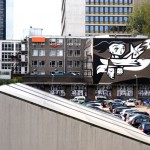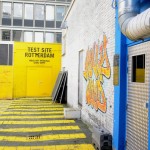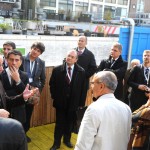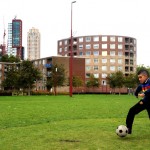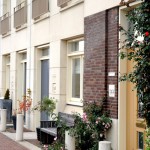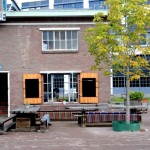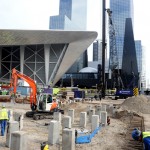The mission – is a project initiated by Eurodite and part of the DISC (Dutch Initiative for Sustainable Cities – www.disc-network.eu) activities. Together with Emil Boc, the Mayor of Cluj, Vice Mayors in Bucharest, Cluj, Constanta, Timisoara and Head Architects of Cluj and Bucharest, a representative of the port of Constanta, as well as other professionals in the connected ministry, we have been in an intense and dense visit to Rotterdam, Eindhoven and Utrecht. The top Romanian delegation met Vice Mayors and members of other ministries, their peers, and learned about projects already carried out and a way to manage. The mission worked out in these three days the targets of DISC platform, made to provide Dutch support to Romanian cities and their effort to build up initiatives meant to revive urban regions and areas ignored so far.
The Dutch programme was connected to development issues in the four participating Romanian cities: port city, cultural city, knowledge city, and the aims was to show urban (re)development projects, public-private models, management and financing of large projects, use of EU funds in urban development. The program was well designed and relevant, and discussions are underway to implement projects through a partnership with DISC. The themes of these projects aims to develop water fronts in an urban context, research and IT campuses (Timisora – Eidhoven), and cultural capital (Cluj-Utrecht). Invited by Eurodite team, Zeppelin was present in The Mission and hopes that this whole project of information exchange and know how will be implemented in Romania.
Day 1- Rotterdam – urban vision
A cosmopolitan cities with over 170 nationalities, 400 years of experience in shipping and trade, the largest harbour of Europe and the 5th in the world, physically connected to Europe through numerous traffic lines, trains, and flights, but also optic fiber and cable, it is the ideal city for entrepreneurs and business ideas. It is an international hub from all points of view, both economically and culturally. A city of university campuses and research centres, it is the place where an educated and entrepreneurial class comes up, and not in the least, it is a city of modern and contemporary architecture, not only because of the largest number of architecture offices in the Netherlands, but also through the quality of production. We speak about the city which was completely rebuilt in the modernist spirit after the war, we talk about the city of Rem Koolhaas, MVRDV, Mechanoo etc.
Central Station is going to be completed in 2013, and will host no less than 750 parking lots for cars and 5350 bike places.
A document known as Urban Vision sets the development directions of the city until 2030. Rotterdam stands for a truly dynamic industrial history, but which needs to meet a new international economic competition. The local authority thinks it is necessary to go from the industrial economy to a services and knowledge-based economy. This knowledge-based economy relies its performances on people with intellectual skills and performances, high professional and managerial ones, and they need to be attracted and settle in the city. For this reason, the balance of the social life and the quality of life, the development of new housings are a priority in Rotterdam. Creative workers and graduates of universities are seen as a vital human resource to raise economically the whole region.
About trust and duties
Henk Snoeken, Deputy Director in the Ministry of Infrastructure and Environment, made a presentation about how the political system works in the Netherlands in general, and how this interacts with urban development. The Dutch government deals with national issues and national responsibility.
In this respect, they organize the legal framework so that each of the 12 regions (provinces) and towns can take over their role, covering rules and procedures for local authorities. There are four areas of national importance in which the government intervenes: security, water management, economic growth and connectivity. Mr Snoken showed that, within these priorities, investments are currently directed to supporting urban densities, the places which are stable and economically flourishing and which may return incomes from taxation. The priority goes to projects which make the already existing areas become able to bring more money and, consequently, contribute to taxation and, implicitly, to wealth.
One example in which the government takes this active role is, for instance, the development of metropolitan regions, Amsterdam and Rotterdam, while for the brainport Eindhoven the role is rather catalyzing. Urban development is left as political decision to the regions and cities negotiating their interests. Politics is thus based on a higher level of decentralization.
Going out together on the streets in Rotterdam, I have seen not only an extremely modern city, with the highest density of superstars and iconic buildings in the Netherlands, but I fully felt the neoliberal spirit, the initiative, the entrepreneurial spirit seen at any corner.
Leading through trust
The targets and ambitions for 2040 are: cities economically competitive, safe, accessible and more enjoyable for living. To apply such a process which extends for about 28 years from now one, it is necessary for people to first acknowledge the viability of these targets, and that happens when the interests of several parties are truly represented. Trust is not an electoral slogan, but a social and cultural value difficult to reach and preserve, but, at the same time, I understood the importance given by the Dutch to this issue and the pragmatic character of building trust. Its effectiveness measures when complex political and economic mechanisms can work.
The efficacy of building trust can validate itself when complex political and economic mechanisms can work. The ambitions for 2040 take into consideration the differences between regions with specific economic powers, their distinct qualities and potential for development, the priorities for investments per regions, so that there is an international differentiation. The stability of plans is covered on the long term through the management of funding for multi-annual development. Half goes to new investments; the other half is allocated to continuing and preserving started projects. Thus, even if the political balance changes, the continuity is ensured.
Images with a wooden passage starting from the backyard of certain buildings (the setup for an underground stage – truly fashionable here) and which goes through an abandoned building, to go down later into a busy street. Each wooden board has the names of the sponsors. One of the young people’s initiatives, supported by the city hall to stimulate the spirit of the community.
New models of action for Rotterdam City Hall
Mr Koen Westhoff explains how Rotterdam City Hall operated as a private actor until 2008; through various development agencies, it owned and sold land, but also the air over the buildings. The money would come from selling the right to air for the vertical extension of buildings or the land, to build new buildings. When the crisis came, it was no longer possible to apply those instruments.
If until 2008, there was a model based on growth (new constructions to be sold), on setting a need and covering it, today the municipality needs new types of sustainability, finding its resources, but also needs to come up with new ideas and support the initiatives of private partners it works with. The new model of real estate practice means brings now the answer to a real need and finding the adequate offer, and not the production of a need.
Higher risks possible for any investment made the city hall turn into a partner and coordinator, or facilitator in projects, be them with European funding (JESSICA, for instance) or investment funding, such as cooperativism.
An urban rehabilitation with social housings and private investments on the other side, a mix leading to diversity and cultural integration. In the middle, a free park good for sports or beach.
Electoral urban planning versus city branding
City branding does not come out with one logo or key holder with armorial bearing only. After all, how many city brands do you know as visuals? They may not be worth anything. City branding means imprinting a distinctive, personalized image to streets and parks, but also to the experiences (mainly touristic ones) someone gets in that place. Something one is to remember. City branding is at the intersection of architecture (under way in Rotterdam there are works by Wiel Arets, Alsop, MVRDV, OMA), design, shopping, entertainment, public events, leisure, parking and urban planning. This way, branding can be defined as a strategy deeply linked to the local economy of a city, but also in its spatial configuration. And, of course, the city branding has its political message. We have certainly came up with the concept at the other end of electoral urban planning based on violent urban interventions, visible and noisy, which need to get their own political message, but in one direction only. We are good. The best. You know what I mean.
An urban rehabilitation with social housings and private investments on the other side, a mix leading to diversity and cultural integration. In the middle, a free park good for sports or beach. Those housings were retracted one meter from the maximum alignment. People enjoy their private meter. They sometimes go out with chairs and tables to look at the water, other times they make a garden.
Hands on work
While densifying areas already built and taking maximum advantage of the modern built heritage, the strategy of Rotterdam City Hall to get a prosperous economy currently relies on co-participation, drawing in urban actors. When projects imply stakeholders, not only the locals, and investors as well, the discourse goes beyond the electoral level. To reach a powerful economy and turn Rotterdam into an attractive city, it is necessary to have investments in the public space and to plan for water flows, in accessibility (public transport and bikes have a huge role), in a clean environment, and once again in preserving and making known the cultural and architectural heritage. The meetings between the stakeholders pointed out the needs for specific projects and programmes. From training taxi companies to provide clearer and more detailed information to tourists, up to attracting internationally known sports events which bring money. Also, policies related to high buildings and their relation with the public space were designed, with a focus on the volumetric configuration which has to allow sufficient lighting and sun, but also less air currents. The ground floor of high buildings is also the subject of a distinctive policy, being seen vital as a business element.
The setup of a restaurant in one of the former industrial halls keeps the spectacular character of the space and the steam machines, which were preserved.
Day 2: Eindhoven Brainport
If Amsterdam is an airport and Rotterdam is the largest harbour, Eindhoven took the role of a port for ideas and creativity. The association with the image of a port is very good, since in this case the international scale at which things take place is important, the opening to several subjects and the high density of ideas up and down and connecting cities or other technological centres. The Brainport started as an European-funded programme, but now is self-sustainable. The Municipality of Eindhoven supports the Brainport, funding it partially, or facilitating the access to funding or political networks. The history of Eindhoven is certainly connected to the presence of top electronic technologies, the best known being Philips, but there are others as well. The Brainport has a serious academic heart (Delft University, Design Academy in Eindhoven, High Tech Campus and High Tech Automotive Campus Helmond), and the city invests 1,4 billion euros in research until 2020. The four pillars in the structure of this Brainport are:
1. Human resources (creating more professionals and highly skilled technicians, making use of lifelong learning);
2. Business (supporting several entrepreneurial initiatives, start ups, several lucrative networks and test fields);
3. Technology (several public and private research centres, marketing for a better international positioning);
4. Living conditions (attractive living and accessibility).
In the approach of research projects, the key elements aim at following the regional structure and not solving individual issues, and the management of the project goes to the one with the problem, while the Brainport simply facilitates, after the development of the business plan and its start, and the project is outsourced.
Stijp S: Philips, the former industrial campus, is converted in very low-cost housings and spaces for startup business, skating halls, cafes, restaurants and offices. Each investment in the space conversions takes place gradually, first the occupation and recovering, while the operation goes for 20 years.
The High Tech Eindhoven Campus has over 8000 researchers and 100 companies. The campus has all facilities, from shopping and leisure to parking and integrated housing.
Day 3: let’s meet in Utrech in 2030 –www.cu2030.nl/english
Utrecht has a few major specific features: it is the top Dutch railway junction, but simultaneously a city of serious bikers, the largest university in the Netherlands, and the city with over 50% of high education graduates, the top concentration of companies in the IT Dutch industry. A large rehabilitation project of Utrecht’s centre, more precisely, was initiated by the city hall some time ago. There were 6 people in the small agency taking over that task, and now they are 60. The premises for the start of the project included urban cases either conflicting, or weakly used, about 20,000 bikes parked in the central area which would not allow the correct use of business spaces and therefore a bad economic dynamics, more and more trains full of people brought by the IT, namely an increasingly busy space. The project brings the city a philharmonic, 2 malls, housings, spaces for 30,000 bikes, public spaces, a public transport terminal (train and bus stations), 27 projects for offices and housings of about 3 billion euros, which will develop up to 2030.
Ultrecht Philharmonic, under construction
The ingredients of success for such a mega project: connection, control, change, cooperation and communication. Urban planning has to set rules and the limits of activities, but most important is to make room for the private initiatives. 80% of the actions in this project come from private investors, while the municipality contributes with 20% and manages all stakeholders involved in the game.

